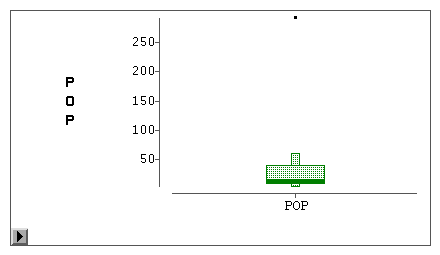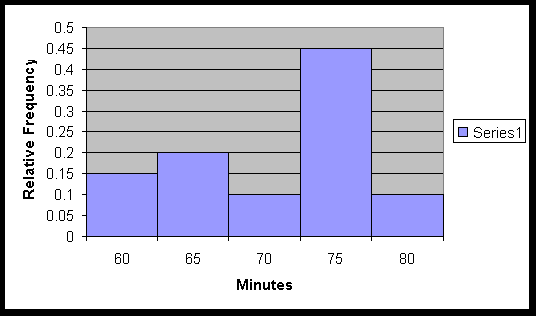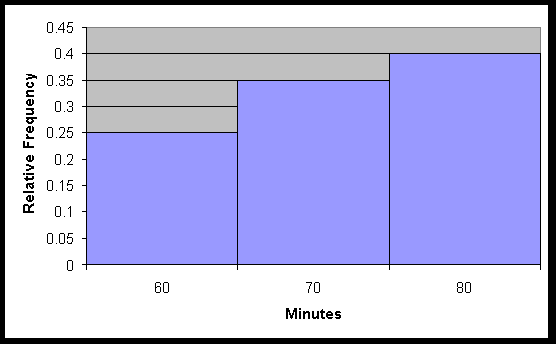Homework #2 -- Suggested Answers
ISBE 2.6, 2.10-2.12, 2.19, 2.23, 2.29
2.6
a. NOTE: These plots were produced using Microsoft Excel and are meant
to give you an idea of what your graph should look like, you should have drawn
your versions by hand.

2.6 a.
b. Median = 11
The first quartile is 8 and the third is 39
c.

2.10
a.

b. Mean = 70.75, Mode = 75
2.11
a.

b. Mean = 71.5, Mode = 80
2.12
|
Grouping |
Mean |
Mode |
|
Original Data |
70.4 |
Not Defined |
|
Fine Grouping |
70.75 |
75 |
|
Coarse Grouping |
71.5 |
80 |
- The mode is not a very good measure of central tendency since it depends
on the arbitrary grouping of the data.
- The fine grouping gives a closer approximation to the mean of the
original data.
2.19
a. A 3-D plot like this is nice, but not necessary. 3 separate
histograms, stacked one above the other, or 3 box plots next to each
other would do the trick.

Yes, there appears to be a downward trend. Lower viscosities are
more frequent by day 3. In addition, the data become less variable
as time passes.
b.
Yes, both the mean and standard deviation decrease as time passes, the
former reflecting the downward trend in viscosities, the later reflecting
the decrease in variability in viscosity measurements.
c.
|
Mean |
Standard Deviation |
|
Day 1 |
74.8 |
4.84 |
|
Day 2 |
71.3 |
4.14 |
|
Day 3 |
70.3 |
2.75 |
The mean for the 150 observation is 72.13 and the standard deviation
is 4.43. The mean is related to the above in that it equals the average
of the three day means. The overall standard deviation is larger than
the average of the three daily standard deviations.
2.23
- The average length is 40 feet.
- The total area is 12,000 square feet and the average area is 2,400
square feet.
- No (the square of a sum of numbers divided by their number
does not, in general, equal the sum of squares of those numbers divided
by their number).
2.29
- The Berezina River -- the army went from 50,000 men to 28,000. It was
about -20 degrees (centigrade).
- Two groups split off early: 30,000 were added at Bota and 6,000 added near the end.
- A soldier had about a 24% chance to make it Moscow alive. A soldier returning to
Poland from Moscow had a (20,000/100,000)= 20% chance of making it as far as Bota.
Those that made it that far had a (4,000/50,000) = 8% chance of returning. The chance
of returning from Moscow is 0.20*0.08 = 1.6% (the book seems to be in error, they
estimate 2.5%). Remember that of the 10,000 soldiers that managed to return to
Poland a portion of them were among the 36,000 soldiers from question b.
2.
- The five number summary: median = 3.8, first quartile = 3.575, third quartile = 4.4, the lowest individual value = 2.2, the highest individual value = 9.6, IQR = 0.825
- The mean = 4.191667, the standard deviation = 1.81932
- The mean = 3.7, the standard deviation = 0.67082
- The five number summary: median = 3.7, first quartile = 3.55, third quartile = 4.15, the lowest individual value = 2.2, the highest individual value = 4.5, IQR = 0.6
- Percentile-based measures (median and IQR) are more robust statistics--they are more resistant to a change from a wild swing in a single observation.





